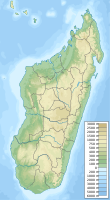Sainte Luce Reserve
|
Sainte Luce Reserve
|
||
| location | Manafiafy ; Madagascar | |
| surface | 0.4 | |
| Geographical location | 24 ° 48 ′ S , 47 ° 10 ′ E | |
|
|
||
| Setup date | 2009 | |
| administration | Association Filana | |
Sainte Luce Reserve is a protected area in southeast Madagascar and one of the last remaining intact coastal rainforests in the country. It is part of the larger Sainte Luce Rainforest , which stretches about 15 km in length and between 100 m and 700 m in width. The reserve is about 1 km long and an average of 300 m wide.
Threats
The coastal rain forest in this region is strongly influenced by deforestation , slash and burn risk, and shifting cultivation (slash-and-burn farming, Madeg .: "tavy").
The forests around Tolagnaro are also threatened because they grow on sands containing titanium . It is to be feared that these areas will be released for mining. That would be particularly fatal as there are species in this area that are endemic and are only found there even in Madagascar.
Sainte Luce Reserve is part of the Lemur Conservation Network , an organization that fights for the preservation of Malagasy lemurs .
Flora and fauna
The area of the reserve is located in a coastal rainforest, the main tree species of which are screw trees ( pandanus ). There is a fascinating diversity of animal and plant species: five lemur species live in the area, including the collar lemur ( Eulemur collaris ), which was only discovered and described in the reserve in 1990. He only lives in this area.
The Sainte Luce mouse lemur (Sainte Luce Mouse Lemur, Microcebus saintelucei ) also occurs and it is assumed that it is also a separate species, as the reserve is bordered by rivers. Other species are Western fat- tailed lemur (Fat Tailed Dwarf Lemur, Cheirogaleus medius ) and Southern woolly lemur ( Avahi meridionalis ).
There are also around 50 reptile species, 50 bird species and another 200 tree species, as well as a large number of land snails . Among the tree species, the strongly threatened palm species Dypsis saintelucei deserves special mention, of which only 300 fully grown trees still exist. The other trees were felled to make crab traps. The mineral ilmenite (titanium iron ore) occurs in the area and is mined.
protection
The idyllic location and the rich animal life make the reserve one of the key locations for volunteer conservation workers in Madagascar. The reserve is managed by a small non-profit organization . Volunteers carry out the conservation projects, such as lemur research, sea turtle monitoring, seed extraction , reforestation and awareness- raising work .
Individual evidence
- ↑ Roland C Goevenain, Johm Silander: Structure and Composition of a Forest Fragment in Eastern Madagascar in Relation to Human Disturbance August 2000, ISBN 2-903700-04-4 , pp. 45-62. in diversity et endémisme à Madagascar.
- ↑ Vincelette, L Randrihasipara, JB Ramanamanjato, PP Lowry, JU Ganzhorn: Mining and environmental conservation: the case of QIT Madagascar Minerals in the southeast: The natural history of Madagascar , SMGoodman, JP Benstead, editors, The University of Chicago Press, Chicago 2003, pp. 1535-7.
- ↑ Russell Mittermeier, EE Louis, M. Richardson, C. Schwitzer, O. Langrand, AB Rylands, F. Hawkins, S. Rajaobelina, J. Ratsimbazafy, R. Rasoloarison, C. Roos, PM Kappeler, J. MacKinnon: Lemurs of Madagascar. Illustrated by SD Nash, Conservation International 2010. ISBN 978-1-934151-23-5
- ^ N. Garbutt: Mammals of Madagascar, A Complete Guide . A&C Black Publishers, 2007, ISBN 978-0-300-12550-4 , pp. 164-165.
swell
- SM Goodman, JP Benstead: The Natural History of Madagascar. 2007.
Web links
- Home - Sainte Luce Reserve . sainte-luce-reserve.com. Retrieved February 5, 2017.
- Home - Lemur Conservation Network . lemurconservationnetwork.org. Retrieved February 27, 2017.
